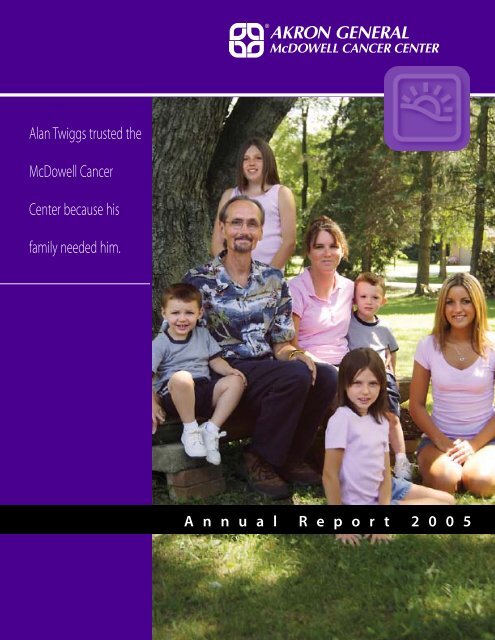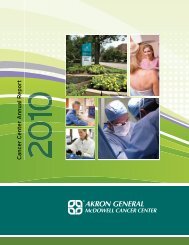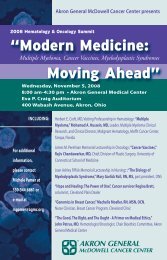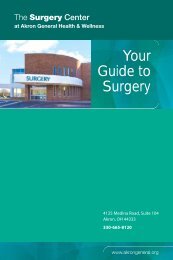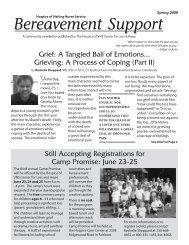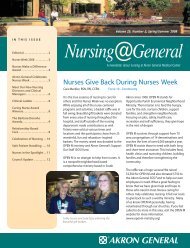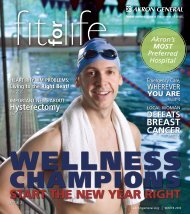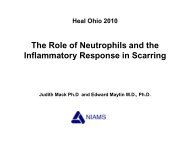Alan Twiggs trusted the McDowell Cancer Center because his family ...
Alan Twiggs trusted the McDowell Cancer Center because his family ...
Alan Twiggs trusted the McDowell Cancer Center because his family ...
You also want an ePaper? Increase the reach of your titles
YUMPU automatically turns print PDFs into web optimized ePapers that Google loves.
The Year in ReviewTechnology and research continued to grow and provide a majoremphasis on our program, allowing us to provide more diagnostics and<strong>the</strong>rapies to our patients.MCDOWELL INPATIENT ONCOLOGY UNIT (5400)Through <strong>the</strong> generosity of former patients and <strong>the</strong>ir families, <strong>the</strong> MineardFamily Lounge and Hershey Family Room were completely updated in 2005.These facilities provide a living room, kitchen, bed, desk and seating to offermore comfort for families during inpatient stays. Additional class space wasalso renovated to double as an outpatient treatment room, if needed.MCDOWELL OUTPATIENT CANCER TREATMENT CENTEROrientation Express, a weekly class that helps educate patients and <strong>the</strong>irfamilies on cancer treatment, premiered in July. The class provides an overviewof chemo<strong>the</strong>rapy, side effects, symptom management and support services. Italso offers <strong>the</strong>m a chance to meet our treatment team and ask questions.Involving patients in <strong>the</strong>ir care can mean a better treatment experience.MEDICAL HEMATOLOGY & ONCOLOGYMedical Oncology & Hematology added <strong>the</strong> use of several agents includingAvastin, Cetuximab and Revlimid to enhance <strong>the</strong> response to standardapproaches to <strong>the</strong>rapy. Hematology & Oncology developed and met cleargoals for each of <strong>the</strong> subcommittees of <strong>the</strong> <strong>Cancer</strong> Committee. Multispecialtyprograms, such as <strong>the</strong> Breast Health <strong>Center</strong>, helped reduce diagnosis timeand time to cancer treatment. Plans for a Lung <strong>Cancer</strong> Clinic in 2006were underway.SURGERY2005 marked <strong>the</strong> first year of a BreastSurgery Fellowship program in conjunctionwith Aultman Hospital and its <strong>Cancer</strong> <strong>Center</strong>Medical Director, Elef<strong>the</strong>rios (Terry)Mamounas, MD. T<strong>his</strong> new position supportsan expanding partnership with <strong>the</strong> geneticscounseling services of Akron Children’sHospital to explore genetics counseling forbreast and colon cancer.Research efforts of <strong>the</strong> Department ofSurgery continued to be multifocal, withstudies involving early breast cancer, sentinel lymph node biopsy and less prolongedmethods to irradiate <strong>the</strong> primary tumor. Clinically, <strong>the</strong> use of intraoperativeultrasound has played an expanded role during surgery to help removeor obliterate tumors.MCDOWELL RADIATION ONCOLOGY DEPARTMENTIn 2005, <strong>the</strong> Department of Radiation Oncology facilitated 27, 954 treatments.The purchase of a multileaf linear accelerator allowed more patients to receiveIntensity Modulated Radiation Therapy (IMRT) at a partnering hospital inPortage County – closer to <strong>the</strong>ir home, where <strong>the</strong>y feel <strong>the</strong> most comfortable.We also began offering High Dose Radiation (HDR) Therapy services, enablingmore precise treatment of cervical cancer patients.GYNECOLOGIC ONCOLOGYThe first total laparoscopic hysterectomy and <strong>the</strong> first hand-assisted totallaparoscopic hysterectomy for uterine cancer were performed in 2005 at AkronGeneral Medical <strong>Center</strong>.A GYN Subcommittee was formed to review registry data, evaluate compliancewith National Comprehensive <strong>Cancer</strong> Network (NCCN) guidelines and developgoals for gynecologic cancer services.CANCER RESEARCHAkron General Medical <strong>Center</strong> participates in National <strong>Cancer</strong> Institutesponsored clinical trials, as well as pharmaceutical industry sponsored trials.All research studies are given vigorous scrutiny by a review committee,endorsement by disease site specific subcommittees and final approval byAkron General Medical <strong>Center</strong>’s Institutional Research Review Board. Theoncology clinical research department in 2005 continued its participation in avariety of clinical trials for all stages and types of cancer.Akron General Medical <strong>Center</strong> is a member of six National <strong>Cancer</strong> Institutecooperative groups. T<strong>his</strong> provides our patients access to a wide menu ofclinical trials.Registrations for cooperative, pharmaceutical and in-houseinvestigator-initiated studies in 2005:American College of RadiologyImaging Network (ACRIN) 1American College of SurgeonsOncology Group (ACOSOG) 1Radiation Therapy Oncology Group (RTOG) 6Southwest Oncology Group (SWOG)[Includes Phase III trials from <strong>the</strong> Clinical Trial Support Unit (CTSU)] 27National Surgical AdjuvantBreast and Bowel Project (NSABP) 27Gynecologic Oncology Group (GOG) 9Pharmaceuticals 23In-house Investigator-initiated 61Total Registrations 155The Commission on <strong>Cancer</strong> requires a 6% accrual rate for commendationstatus. Total registrations at Akron General Medical <strong>Center</strong> represent nearly an11% accrual rate of total analytic cases.
COMMUNITY OUTREACH• 371 uninsured women received screening mammograms at no costthrough Akron General’s Muffins for Mammograms program. 2005 marked<strong>the</strong> program’s 13th year.• 407 men, through <strong>the</strong> Bro<strong>the</strong>r-to-Bro<strong>the</strong>r project, received PSA screeningtests without charge at community-based locations. These are men whomight not o<strong>the</strong>rwise have been screened for prostate cancer.Akron General was a key partner in t<strong>his</strong> grass-roots awareness program.Both <strong>the</strong> Muffins for Mammograms and <strong>the</strong>Bro<strong>the</strong>r-to-Bro<strong>the</strong>r Project were selected by <strong>the</strong>Ohio Department of Health as Ohio <strong>Cancer</strong>Control Model Programs based on <strong>the</strong>ir creativityand impact on cancer detection and prevention.• Participated in local health fairs in <strong>the</strong> communityand at area business. The most attended eventwas <strong>the</strong> 9th Annual Summit County MinorityHealth Fair, which offered a variety of healthscreenings and information for 1,500 attendees.• Participated as an active member of <strong>the</strong> SummitCounty Colorectal Task Force in conjunction with American <strong>Cancer</strong> Society.Akron General continues working on initiatives to improve prevention andearly detection of colorectal cancer.• Continued collaboration with <strong>the</strong> American <strong>Cancer</strong> Society, <strong>the</strong> medicalcommunity, and o<strong>the</strong>r groups to assist our patients in gettingneeded services.• Offered PICS (Photos in <strong>Cancer</strong> Surveillance), an educational seminar onskin-self photography of pigmented skin lesions. The program provided ateaching tool on <strong>the</strong> types of skin cancer, how to do a skin-self exam andsun avoidance.• 173 people were screened at <strong>the</strong> Annual Skin <strong>Cancer</strong> Screening onApril 30 at <strong>the</strong> <strong>McDowell</strong> <strong>Cancer</strong> Treatment <strong>Center</strong>.• Offered ongoing support to Stewart’s Caring Place - a local organizationthat offers support groups, resource information and a menu of programsand services free of charge to patients and families affected by cancer.<strong>McDowell</strong> <strong>Cancer</strong> <strong>Center</strong> staff assisted with presentations, support groupsand o<strong>the</strong>r programs.• Offered Conversations on <strong>Cancer</strong>, an educational series for patients, <strong>the</strong>irfamilies and <strong>the</strong> community, that helped individuals learn more about <strong>the</strong>ircancer risks, early detection and treatment options. Physician specialistsand o<strong>the</strong>r healthcare professionals presented information on cancer topics.• Promoted prevention, early detection and screening programs throughguest appearances on Akron WAKR 1590 Good Health Radio Hour andCleveland WKYC TV- 3.PROFESSIONAL EDUCATION2005 Hematology & Oncology SummitOur three major oncology programs were combined to honor 30 years ofprofessional education in oncology on November 2, 2005. They included <strong>the</strong>30th annual James M. Perelman Visiting Professorship, <strong>the</strong> Herbert E. Croft, MD,Visiting Professorship in Hematology and <strong>the</strong> 20th annual “Joan Ashley FiffickMemorial Lectureship in Nursing.” These educational opportunities foroncology professionals are funded each year through <strong>the</strong> generous supportof our donors.James M. Perelman VisitingProfessorship speaker: John H. Winston,III, MD, FACS, FASCRS, AssistantProfessor of Surgery, James <strong>Cancer</strong><strong>Center</strong>, presented “LaparoscopicColectomy for <strong>Cancer</strong>.”Herbert E. Croft, MD, VisitingProfessorship in Hematology speaker:James M Rossetti, DO, AssistantDirector, Blood & Marrow TransplantProgram, Western Pennsylvania Hospital,presented “Myelodysplasia:Recent Advances.”Joan Ashley Fiffick MemorialLectureship in Nursing speakersincluded Sandra Hazra, MD, CM, Assistant Professor of Internal Medicine,Nor<strong>the</strong>astern Ohio Universities College of Medicine, presented “Joan, YouTaught Us a Lot…. We ARE Getting Better;” and Sally Karioth, RN, PhD,Motivational Speaker, The Goodman Speakers Bureau, Inc., presented, “Put onYour Own Oxygen Mask First.”PHILANTHROPYOver <strong>the</strong> years, <strong>the</strong> Akron General Development Foundation, <strong>the</strong> AkronGeneral Women’s Board, private donors and local companies have continuedto provide significant support through fundraising for <strong>the</strong> programs andservices of <strong>the</strong> <strong>McDowell</strong> <strong>Cancer</strong> <strong>Center</strong> – including research dollars,professional education, community education and awareness, screeningprograms and patient support services.Through donations and dollars raised from events in 2005, Akron General wasable to provide much needed services and items, including 371 mammogramsat no cost to women in <strong>the</strong> community, free prostate cancer screenings for407 local men, a renovated <strong>family</strong> space for our inpatient unit, camisolesfor mastectomy patients, medications, medical equipment and supplies andmuch more.For 30 years, educational endowments have supported local educationalopportunities for oncology professionals and physicians and nurses, to ensurethat <strong>the</strong> highest level of cancer care is available right here in our community.Net Proceeds in 2005 from Akron General Development Foundation eventsand donations to benefit <strong>the</strong> <strong>McDowell</strong> <strong>Cancer</strong> <strong>Center</strong> and cancer patientstotaled: $445,570.2005 Fundraising Events5th Annual Dolores Sawan 5K Memorial Run & 1-Mile Walk forOvarian <strong>Cancer</strong>Muffins for MammogramsWQMX’s Bosom Buddies to benefit Muffins for Mammograms13th Annual Janell B. Izzo Golf Tournament5th Annual Grape Escape wine and food-tasting event
Site Analysis:Head and neck cancers are one of <strong>the</strong> less common disease categories treated atAkron General Medical <strong>Center</strong>, but <strong>the</strong>y often require very complicatedtreatments with careful coordination of care between many departments. Themajority of <strong>the</strong>se patients present at middle age or later and usually havecomorbid conditions that affect our ability to render appropriate care easily.The backgrounds of many but not all of <strong>the</strong>se patients include extensive tobaccoand alcohol use, which may already have led to emphysema, diabetes mellitus,chronic heart disease, malnutrition and cirrhosis. Fur<strong>the</strong>rmore, head and neckcancers are a diverse set of malignancies, which require individualization of carefor each site and stage of disease. The sites of disease are formally divided intonasopharynx, hypopharynx, and oral cavity, and are subclassified into Stages I, II,III, and IV, each of which is treated in unique fashion.Treatment of <strong>the</strong> earlier stages is generally surgical, but with advanced stagesradiation and chemo<strong>the</strong>rapy are added and given concurrently, vastlycomplicating delivery of care. These latter treatment programs may result in majormorbidity during care and long-term complications.The treatment of a Stage IV patient may require an extensive range ofservices including:• ENT for diagnosis, staging and occasionally tracheostomy;• Interventional Radiology for placement of feeding gastrostomy tube andR-Port placement for intravenous access for infusional chemo<strong>the</strong>rapy, as wellas for providing detailed imaging studies;• Radiation Oncology for IMRT planning and treatment;• Medical Oncology for chemo<strong>the</strong>rapy planning;• Oral Surgery for acute dental care;Figure 3 Head & Neck <strong>Cancer</strong> Treatment at Diagnosis (2000 - 2003)AGMC vs. Ohio vs. NCDBPercent of Cases3530252015105020.531.1 30.8AGMC = 107 OHIO= 4,062 NCDB = 90,25213.1 13 12.824.3 25.2 20.924.313Surgery Radiation Surg/R R/C S,R&C Chemo O<strong>the</strong>r18.6Head and Neck<strong>Cancer</strong>s8.46.65.81.9.5 .72.8 2.43.1Data Source, NCDB, Commision on <strong>Cancer</strong>, ACoS Benchmark Reports• <strong>Cancer</strong> Treatment <strong>Center</strong> nurses and outpatientinfusion services for administration ofchemo<strong>the</strong>rapy;• Nutrition services for dietary support;• Social Services for financial and social support(as many of <strong>the</strong>se patients lack insurance and<strong>family</strong> resources);• Internal Medicine to manage <strong>the</strong> chronicmedical diseases which may be severe;by Es<strong>the</strong>r H. Rehmus, MD• Rehabilitation <strong>the</strong>rapy to assess speech and acute swallowing problems andhelp with rehabilitation once <strong>the</strong> antineoplastic treatment is completed.It is also common for <strong>the</strong>se patients to require inpatient care during treatment todeal with <strong>the</strong> dehydration, pain, skin reactions, and infectious complications of<strong>the</strong>se intensive treatments.In <strong>the</strong> years 2000-2003 we saw 107 head and neck cancer patients at AkronGeneral Medical <strong>Center</strong>. The age and stage at diagnosis are comparable toOhio and NCDB patients (See Fig. 1 & 2). Reflecting <strong>the</strong> multidisciplinaryapproach used at Akron General and following national guidelines, fewer patientswere treated with surgery alone but ra<strong>the</strong>r with combination <strong>the</strong>rapy comparedto state and national data (Fig. 3). Despite <strong>the</strong> predominance of late stagepresentations and <strong>the</strong> difficulties inherent in treatment, head and neck cancerscan be cured.Figure 4 shows <strong>the</strong> five-year survival by stage. Overall five-year survival data fromAkron General patients from 1995-2000 shows that our patients do somewhatbetter compared with Ohio and National patients (See Fig. 5). Our hope is thatover <strong>the</strong> next years more effective chemo<strong>the</strong>rapy and <strong>the</strong> use of IMRT will lead togreater overall five-year survival rates and reduction of <strong>the</strong> attendant morbidityof treatment.Given <strong>the</strong> variability of patient presentation and <strong>the</strong> difficulty of treatment, fewclinical trials are available for head and neck cancer patients. Five patients havebeen entered in study protocols since in 2003. Two new clinical trials were openedin 2005, one for treatment of relapsed disease in previously treated patients; <strong>the</strong>second protocol uses chemo<strong>the</strong>rapy and radiation <strong>the</strong>rapy with Cetuximab(a monoclonal antibody) for advanced stage head and neck cancer patients.Patients who achieve five-year disease-free survival seldom develop recurrence of<strong>the</strong>ir head and neck cancers. They remain at increased lifetime risk for secondmalignancies. Our hope is that tobacco use can be eliminated as a significant riskfactor for <strong>the</strong>se cancers. We thus take great pride in Akron General’s smokingcessation programs and policies and plans for a smoke-free campus.Figure 4 Head & Neck <strong>Cancer</strong> Survival by Stage (1995 - 2000)AGMC = 184 casesPercent of Cases1009080706050403020100Stage 0 Stage I Stage II Stage III Stage IV10093.583.374.274.172.18783.3 83.383.2 82.678.16457.253.950.551.644.844.842.135.30 12 24 36 48 60Months71.266.744.843.333.6Data Source, NCDB, Commision on <strong>Cancer</strong>, ACoS Benchmark ReportsFigure 5Percent of Cases1009080706050403020100Head & Neck <strong>Cancer</strong> Overall Survival by Life Table(Observed) 1995 - 2000 5 year survival AGMC vs. Ohio vs. NationalAGMC = 184 OHIO = 1,057 National = 23,4381000 12 24 36 48 60Months of Survival48.746.244.4Data Source, IMPAC Medical Systems
2005 Primary Site Incidence ReportTotal Male Female Analytic Non- ClinicalCases Analytic TrialsHEAD & NECK SITESTongue 6 3 3 5 1 0Salivary Glands 4 3 1 4 0 0Floor of Mouth 1 1 0 1 0 0Gum & O<strong>the</strong>r Mouth 3 3 0 3 0 0Nasopharynx 2 1 1 2 0 0Tonsil 2 2 0 2 0 0Oropharynx 1 0 1 1 0 0Hypopharynx 2 0 2 2 0 0Oth Oral Cavity & Pharynx 0 0 0 0 0 0Total Head & Neck 21 13 8 20 1 0DIGESTIVE SYSTEMEsophagus 12 9 3 12 0 0Stomach 16 10 6 12 4 0Small Intestine 4 4 0 4 0 0Large IntestineCecum 23 8 15 23 0 0Appendix 2 1 1 2 0 0Ascending Colon 10 7 3 10 0 1Hepatic Flexure 5 3 2 5 0 2Transverse Colon 5 1 4 5 0 2Splenic Flexure 4 3 1 4 0 0Descending Colon 3 2 1 3 0 0Sigmoid Colon 16 9 7 16 0 1Large Intestine, NOS 5 1 4 2 3 0Total Colon, excluding rectum 73 35 38 70 3 10Rectosigmoid Junction 7 3 4 7 0 0Rectum 41 24 17 39 2 2Total Rectum & Rectosig Junct 48 27 21 46 2 2Anus Canal 5 2 3 4 1 1Liver 4 4 0 4 0 0Intrahepatic Bile Duct 1 1 0 1 0 0Total Liver & Intrahep Bile 5 5 0 5 0 0Gallbladder 1 0 1 1 0 0O<strong>the</strong>r Biliary 2 1 1 2 0 0Pancreas 22 7 15 21 1 4Retroperitoneum/Peritoneum 0 0 0 0 0 0Total Digestive System 188 100 88 177 17 17RESPIRATORY SYSTEMNose, Nasal Cavity 2 1 1 2 0 0Larynx 15 12 3 15 0 0Non-small Cell Lung 178 100 78 164 14 7Small Cell Lung 37 14 23 36 1 3Trachea, Mediastinum 0 0 0 0 0 0Total Respiratory System 232 127 105 217 15 10BONES AND JOINTS 3 2 1 3 0 0SOFT TISSUE - INCLUD. HEART 12 8 4 12 0 0SKINMelanoma 72 32 40 70 0 0Non-melanoma skin 9 6 3 7 2 0Total Skin Sites 81 38 43 77 4 0Total Male Female Analytic Non- ClinicalCases Analytic TrialsMALE ORGANSProstate 235 235 0 217 18 0Testis 18 18 0 18 0 0Penis/O<strong>the</strong>r Male Organs 4 4 0 4 0 0Total Male Organs 257 257 0 239 18 0GENITOURINARYUrinary Bladder 76 54 22 68 8 0Kidney & Renal Pelvis 44 28 16 42 2 1Ureter 1 1 0 1 0 0O<strong>the</strong>r Urinary Organs 2 2 0 1 0 0Total Genitourinary System 123 85 38 113 10 1CENTRAL NERVOUS SYSTEMEye & Orbit 1 0 1 0 1 0Brain & Cranial Nerves 36 21 15 33 3 5Oth Central Nervous System 8 2 6 7 1 0Total Central Nervous System 45 23 22 40 5 5ENDOCRINE SYSTEMThyroid 21 4 17 21 0 0O<strong>the</strong>r Endocrine-incl Thymus 5 4 1 3 2 0Total Endocrine System 26 8 18 24 2 0LYMPHOID SYSTEMHodgkin Disease 20 14 6 18 1 6Non-Hodgkin Lymphoma 33 23 10 29 4 7ExtraNodal Lymphoma 20 13 7 19 1 0Total for Lymphoid System 73 50 23 67 6 13HEMATOPOIETIC/RETICULOLeukemia 20 10 10 19 1 9Multiple myeloma 10 5 5 8 2 3Total Hemato/Reticulo 30 15 15 27 3 12OTHERMeso<strong>the</strong>lioma 5 3 2 5 0 0Kaposi sarcoma 0 0 0 0 0 0Unknown Primary Site 35 16 18 31 4 0Total O<strong>the</strong>r 39 19 20 35 4 0SPECIAL STUDIESMGUS 1EPC Study 9Mood & Cognitive Function 44Total Special Studies 9 1 44ACCUMULATIVE TOTAL 1522 747 775 1421 101 155Note: <strong>the</strong> American Joint Committee on <strong>Cancer</strong> (AJCC) limits its classification to specific anatomical sites andapplicable to carcinoma, sarcoma, lymphoma, and melanoma occurring within those sites.BREAST 239 2 237 227 12 31FEMALE ORGANSCervix Uteri 23 0 23 22 1 0Corpus Uteri 76 0 76 75 1 8Uterus, NOS 1 0 1 1 0 0Ovary 35 0 35 30 5 3Vagina 2 0 2 2 0 0Vulva 13 0 13 10 3 0O<strong>the</strong>r Female Genital 2 0 2 2 0 0Total Female Organs 152 0 152 142 10 42
CANCER REGISTRY STAFFKay F. Lain, RHIT, CTR, CoordinatorColeen DeSalvo, CTR, <strong>Cancer</strong> RegistryCoding TechnicianVictoria Rae, BA, CTR, CodingTechnician/Follow Up SpecialistHannah Carr, SecretaryDEFINITION OF TERMSCLASS OF CASEAnalyticPatients that were first diagnosed and/orreceived all or part of <strong>the</strong>ir first course oftreatment at Akron General.Non-AnalyticPatients diagnosed before <strong>the</strong> reference dateof <strong>the</strong> registry, or diagnosed and treated atano<strong>the</strong>r facility or diagnosed at autopsy.REVIEW BOARDIRRB - Institutional Research Review BoardSTAGE“Manual for Staging of <strong>Cancer</strong>”, Sixth Edition,American Joint Committee on <strong>Cancer</strong>,J.B. Lippincott Co., Philadelphia, 2002.American <strong>Cancer</strong> Society, A <strong>Cancer</strong> Journalfor Clinicians, 2005400 Wabash AvenueAkron, Ohio 44307330-344-HOPE (4673)www.akrongeneral.orgOn <strong>the</strong> Cover<strong>Alan</strong> <strong>Twiggs</strong> attributes <strong>his</strong> recovery fromtonsillar cancer not just to <strong>his</strong> care team at <strong>the</strong>Akron General <strong>McDowell</strong> <strong>Cancer</strong> <strong>Center</strong>, but to<strong>his</strong> <strong>family</strong>, friends and co-workers.He is pictured on <strong>the</strong> cover with wife, Mary,daughters <strong>Alan</strong>a 20, Miranda 12 and Bryanna 8,and three-year old twins Blake and Bryce.<strong>Twiggs</strong> is a zone manager for <strong>the</strong> AkronBeacon Journal and <strong>his</strong> wife Mary is a callcenter specialist for Akron General’sCentralized Scheduling Department.In December 2002, <strong>Twiggs</strong> saw <strong>his</strong> <strong>family</strong>physician, Jon Tosino, MD, for swollen tonsilsand difficulty swallowing. It was Ear, Nose andThroat Specialist Janet Griffin, MD, whoperformed a tonsillectomy and broke <strong>the</strong> newsto <strong>Twiggs</strong> that a mass found in <strong>his</strong> tonsilwas malignant.“I had just found out my wife was pregnant with twin boys. I knew from <strong>the</strong> day Dr. Griffin told me,that I was going to be fine. It was going to work out okay…I was going to get to see my boys.”<strong>Twiggs</strong> was referred to Akron General Oncologist Elizabeth Connelly, DO. <strong>Twiggs</strong> elected toparticipate in an industry-sponsored clinical trial that was available at <strong>the</strong> <strong>McDowell</strong> <strong>Cancer</strong> <strong>Center</strong>using a combination of chemo<strong>the</strong>rapy and radiation <strong>the</strong>rapy.Having never spent a day in <strong>the</strong> hospital before, <strong>Twiggs</strong> spent a total of 30 days as an inpatientthroughout <strong>the</strong> course of <strong>his</strong> treatment. A port was placed in a central vein for easier delivery ofchemo<strong>the</strong>rapy. <strong>Alan</strong> also had to have a feeding tube placed due to extreme weight loss.That year he wasn’t <strong>the</strong> only AkronGeneral patient in <strong>his</strong> <strong>family</strong>.“Our sons were born on February 26,at Akron General. At <strong>the</strong> time Marywent into labor, she was staying withme at <strong>the</strong> hospital during <strong>the</strong> day andnight, so she’d brought her overnightbag with her,” recounts <strong>Twiggs</strong>. “Whenit was time to deliver, she walkeddownstairs and checked in as apatient. They wheeled me down, sothat I could sit beside her duringdelivery and cut <strong>the</strong> boys’umbilical cords.”<strong>Twiggs</strong> attributes <strong>his</strong> strength infighting cancer to <strong>his</strong> <strong>family</strong> and <strong>the</strong>ongoing support of <strong>his</strong> physicians and<strong>Cancer</strong> <strong>Center</strong> staff. He also recognizes<strong>his</strong> co-workers in helping him to fight<strong>his</strong> cancer.“The people that I work with were sogracious and wonderful through <strong>the</strong>whole ordeal. I was off workapproximately seven months. If <strong>the</strong>yweren’t calling, <strong>the</strong>y were stopping byto help us around <strong>the</strong> house.”“As a research site with access to a broadrange of clinical trials, our patients areinformed of and offered <strong>the</strong> opportunity toparticipate in protocols <strong>the</strong>y may qualify toenter, such as <strong>the</strong> one Mr. <strong>Twiggs</strong>participated in,” says Cathy Farmer, RN,OCN, Coordinator of Research andEducation at <strong>the</strong> <strong>McDowell</strong> <strong>Cancer</strong> <strong>Center</strong>.Akron General participates in NCIsponsoredgroups that conduct clinicaltrials such as Southwest Oncology Group,Radiation Therapy Oncology Group,Gynecologic Oncology Group, NationalSurgical Adjuvant Breast and Bowel Project,American College of Surgeons OncologyGroup, American College of RadiologyImaging Network and <strong>the</strong> <strong>Cancer</strong> TrialsSupport Unit. Patients can also participatein industry sponsored, as well asinvestigator-initiated, studies at <strong>the</strong><strong>McDowell</strong> <strong>Cancer</strong> <strong>Center</strong>.


